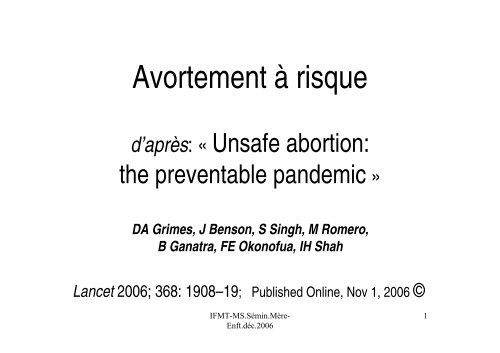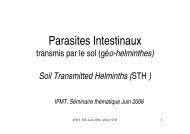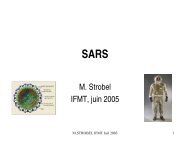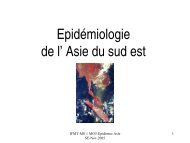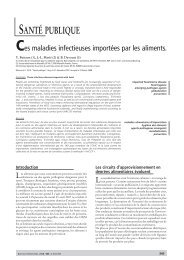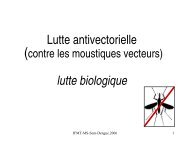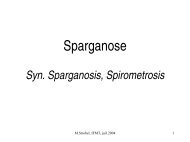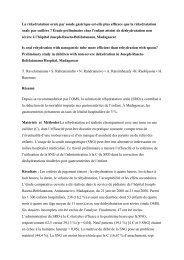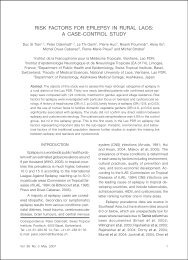DA Grimes, J Benson, S Singh, M Romero
DA Grimes, J Benson, S Singh, M Romero
DA Grimes, J Benson, S Singh, M Romero
Create successful ePaper yourself
Turn your PDF publications into a flip-book with our unique Google optimized e-Paper software.
Avortement à risque<br />
d’après: « Unsafe abortion:<br />
the preventable pandemic »<br />
<strong>DA</strong> <strong>Grimes</strong>, J <strong>Benson</strong>, S <strong>Singh</strong>, M <strong>Romero</strong>,<br />
B Ganatra, FE Okonofua, IH Shah<br />
Lancet 2006; 368: 1908–19; Published Online, Nov 1, 2006 ©<br />
IFMT-MS.Sémin.Mère-<br />
Enft.déc.2006<br />
1
Avortement à risque : définition<br />
• Procédure qui vise à interrompre une grossesse<br />
• Il s’agit d’une grossesse non désirée<br />
• La procédure est pratiquée par :<br />
– un personnel non qualifié, souvent la femme elle même<br />
– ou un professionnel, mais dans un environnement à risque :<br />
instruments non stériles, absence d’hygiène et moyens techniques<br />
élémentaires<br />
IFMT-MS.Sémin.Mère-<br />
Enft.déc.2006<br />
2
Avortement à risque : définition<br />
• Fréquence très sous estimée par les statistiques de santé<br />
(en Inde par ex.: 10-25% des femmes seraient concernées)<br />
• L’Impact de l’avortement à risque est majeur aux plans<br />
– psychologique<br />
– sanitaire : morbidité / mortalité non négligeables<br />
–social: contexte d’ignorance, solitude, pauvreté<br />
– juridique : dans certains pays ou l’avortement est jugé criminel<br />
IFMT-MS.Sémin.Mère-<br />
Enft.déc.2006<br />
3
UA, world perspective<br />
IFMT-MS.Sémin.Mère-<br />
Enft.déc.2006<br />
4
Avortements<br />
non médicaux<br />
répartition<br />
mondiale<br />
lois pro / anti-avortement:<br />
effets sur natalité et sur<br />
mortalité maternelle<br />
IFMT-MS.Sémin.Mère-<br />
Enft.déc.2006<br />
5
IFMT-MS.Sémin.Mère-<br />
Enft.déc.2006<br />
6
Avortements non médicaux<br />
et décès maternels<br />
Causes de décès maternels :<br />
rôle de l’avortement non médical<br />
IFMT-MS.Sémin.Mère-<br />
Enft.déc.2006<br />
7
Unsafe Abortion Methods<br />
1.Treatments taken by mouth<br />
Toxic solutions<br />
• Turpentine<br />
• Laundry bleach, bluing, detergent solutions<br />
• Acid<br />
• Cottonseed oil<br />
• Arak (a strong liquor)<br />
• Teas and herbal remedies, strong tea<br />
• Tea with apio, avocado bark, ginger, etc<br />
• Tea made of livestock manure<br />
• Assorted herbal medications<br />
• Boiled and ground avocado or basil leaves<br />
• Wine boiled with raisins and cinnamon<br />
• Black beer boiled with soap, oregano, and<br />
parsley<br />
• Boiled apio (celery plant) water with aspirin<br />
• “Bitter concoction”<br />
IFMT-MS.Sémin.Mère-<br />
Enft.déc.2006<br />
Drugs<br />
• Uterine stimulants, such as misoprostol<br />
or oxytocin (used in obstetrics)<br />
• Quinine and chloroquine (used for malaria)<br />
• Oral contraceptives (ineffective for abortion)<br />
2. Intramuscular injections<br />
• Two cholera immunisations<br />
• And many others….<br />
8
Unsafe Abortion Methods (contin.)<br />
3. Foreign bodies inserted into the cervix<br />
4. Inserted in the vagina or cervix<br />
• woodden stick, sometimes dipped in oil<br />
• hard green bean, plant root, or leaf<br />
• piece of sugar<br />
•metallic : knitting needle , wire, coat hanger ,<br />
bicycle spoke<br />
• rubber catheter<br />
• intrauterine contraceptive device<br />
• ballpoint pen<br />
• chicken bone<br />
• air blown in by a syringe<br />
• Potassium permanganate tablets<br />
• Herbal preparations<br />
• Misoprostol<br />
5. Enemas (intra vaginal-cervical)<br />
• Soap<br />
• Shih tea (wormwood)<br />
6. Trauma<br />
• Abdominal or back massage<br />
• Lifting heavy weights<br />
• Jumping from top of stairs or roof<br />
IFMT-MS.Sémin.Mère-<br />
Enft.déc.2006<br />
9
1. hémorragie<br />
2. sepsis, choc<br />
3. péritonite, gangrène<br />
Complications<br />
pouvant nécessiter<br />
hystérectomie<br />
4. traumatisme col, vagin, utérus, organes abdominaux<br />
5. Infection génitale haute et stérilité (20-40%)<br />
6. intoxication aigue<br />
Ces complications sont fréquentes : 20-50% des femmes doivent être<br />
hospitalisées pour complication après avortt<br />
le risque augmente avec l’âge de la grossesse<br />
(après le 1er trimestre)<br />
et avec le caractère invasif (intra-utérin) de la procédure<br />
IFMT-MS.Sémin.Mère-<br />
Enft.déc.2006<br />
10
Complications : mécanismes<br />
1. Rétention placenta (avortt incomplet) hémorragie<br />
2. Abortifs chimiques (quinine, chloroquine..) Intoxication aigue<br />
3. Infections systémiques : tétanos,<br />
Clostridium perfringens, BGN<br />
sepsis, choc, décès<br />
4. Perforation d’organes creux péritonite, gangrène<br />
5. Infection loco régionale<br />
1. endométrite synéchies utérus, stérilité<br />
2. péritonite<br />
6. Injection / insufflation (air, savon) embolie gazeuse<br />
7. corps étranger local ulcère, nécrose, fistule<br />
IFMT-MS.Sémin.Mère-<br />
Enft.déc.2006<br />
11
Quelles sont les procédures « safe » ?<br />
1. Méthode médicale : prostaglandines<br />
1. mifepristone<br />
2. misoprostol (cytotec ©)<br />
2. Aspiration<br />
IFMT-MS.Sémin.Mère-<br />
Enft.déc.2006<br />
12
Aspiration<br />
Prostaglandines<br />
(vaccum abortion)<br />
Medical Non-Surgical Abortion<br />
Buy Mifepristone , Mifegyne , RU 486 online<br />
IFMT-MS.Sémin.Mère-<br />
Enft.déc.2006<br />
13
Medical abortion by Misoprostol (MO) (Cytotec*)<br />
in Brazil<br />
• MO (prostaglandin) introduced in Brazil in 1986, rapidlly became available over the counter<br />
• Women recognised its ective abortifacient properties and began to use the drug<br />
• They self-administer the drug orally; seeking medic assistance in case of uterine bleeding<br />
• By 1990, 70% of women treated in hospital for abortion complications in reported use of<br />
MO. This led the MoHof Brazil to restrict its sale in 1991. Some states banned the drug.<br />
• However, restricting did not prevent the use : MO remained available at higher prices on<br />
the black market. Consequently, in some states of Brazil, abortion complications increased<br />
and abortion-related deaths tripled after MO restriction.<br />
• MO globally the severity of UA complications, and the hospital admissions: previously,<br />
foreign bodies inserted into the cervix, caused bleeding urging curettage & infection<br />
• The wide use of MO for abortion has been associated with improved health for women.<br />
• Women have widely accepted medical abortion because of it is similar to spontaneous<br />
abortion.<br />
IFMT-MS.Sémin.Mère-<br />
Enft.déc.2006<br />
14
Images<br />
(diffusées par les pro et les anti-avortements)<br />
IFMT-MS.Sémin.Mère-<br />
Enft.déc.2006<br />
15
Illegal abortion laws: prosecution in El Salvador<br />
• “After I came out of the coma, they moved me to the maternity hospital. My brother<br />
visited and asked me if the police had come to ask me questions. He said the police<br />
had come to our house and they had interrogated our relatives and neighbours. They<br />
had gone to where I worked. They asked everyone a lot of questions about me and who<br />
I was and if they knew whether I was pregnant and whether I’d had an abortion.<br />
• When I got home, the prosecutor came to see me, and he asked lots of aggressive<br />
questions. He talked to me like I was a criminal. I didn’t want to answer because I was<br />
scared. He said if I didn’t answer, even though I was in bad physical shape, he would<br />
put me in jail.<br />
• He wanted me to tell him who the father of the child was and the name of the person<br />
who had done this to me.<br />
• I didn’t know her name. Then he made a date for me to come to the prosecutor’s office.”<br />
Anonymous woman in El Salvador<br />
IFMT-MS.Sémin.Mère-<br />
Enft.déc.2006<br />
16
Abortion: A Buddhist Perspective<br />
Early Scriptures of Buddhism (the Pali canon) see human life as starting with conception.<br />
If life begins at conception, then any termination following this is seen to be morally<br />
unwholesome.To have an abortion is to break the first precept - « abstain from harming or<br />
killing livings beings ». This carries negative karmic consequences which will bear fruit either<br />
in this life or future lives.<br />
It is also to deny the precious opportunity that human life affords for the attainment of enlightenment.<br />
Out of the six realms that make upBuddhist wheel of life, the human realm is seen to be the<br />
most precious.<br />
The basic position taken by Buddhism, therefore, is that abortion is wrong.<br />
But is it ever permissible?<br />
Exceptions? Buddhism recognises an abortion might be necessary - when the mother's life is at<br />
risk, for example. This seems to imply that the mother's life is of greater value than the<br />
embryo or fetus. If this is the case, it might be argued that it is less serious to terminate a less<br />
developed being than a more developed one.<br />
A Buddhist might argue that it is morally worse to kill a dog than an ant,or a holy person than a<br />
murderer. On this basis, is it morally worse to abort a three month old fetus than one at two<br />
months?<br />
IFMT-MS.Sémin.Mère-<br />
Enft.déc.2006<br />
17
Abortion: A Buddhist Perspective (suite)<br />
Shades of Opinion<br />
Individual Buddhists may differ in how they assess to what extent abortion is wrong in individual<br />
cases.<br />
One stance is that abortion at any stage in the pregnancy is wrong.<br />
Another stance might be that the offence is worse the more developed the fetus or embryo.<br />
Yet another might be that the seriousness of the offence can only be determined by taking into<br />
account the full circumstances surrounding the abortion.For example,would it be more morally<br />
reprehensible to have an abortion for personnal convenience than for the threat on mother health<br />
or family wellbeing ?<br />
The degree of moral culpability is always going to bedifficult to measure<br />
IFMT-MS.Sémin.Mère-<br />
Enft.déc.2006<br />
18
Conclusions<br />
1. 19–20 million avortements à risque (AAR) sont pratiqués / an,<br />
97% dans les PED (estim.)<br />
2. 68 000 femmes meurent chaque année, et des millions ont des<br />
séquelles définitives (estim)<br />
3. En dépit de cette fréquence l’AAR, est l’un des aspects de la santé<br />
publique les plus négligés et les plus difficiles à aborder<br />
4. Causes des décès : hémorragie, infection, et intoxication aux abortifs<br />
5. L’accès à la contraception moderne peut réduire mais pas éliminer l’AAR<br />
6. La légalisation de l’A est nécessaire mais pas suffisante à éliminer l’AAR<br />
IFMT-MS.Sémin.Mère-<br />
Enft.déc.2006<br />
19
Conclusions (2)<br />
7. La santé des femmes progresse quant l’A est légal, sûr, accessible;<br />
à inverse, elle se détériore lorsque l’accès est mauvais ou l’A illégal<br />
8. En pays développés, l’A légal est très sûr : < 1 décès / 100 000 A.<br />
9. L’A par aspiration non invasive (manuelle) du contenu utérin, ou par<br />
médicaments (mifepristone / misoprostol) ont considérablement<br />
réduit les complications<br />
10. en PED, traiter ces complications surcharge fortement des services<br />
de santé déjà pauvres, au détriment d’autres maladies curables<br />
11. La cause fondamentale de cette pandémie globale est la paresse, et<br />
le dédain vis à vis des femmes; celles ci souffrent et meurent parce<br />
qu’elles ne sont pas valorisées.<br />
IFMT-MS.Sémin.Mère-<br />
Enft.déc.2006<br />
20


